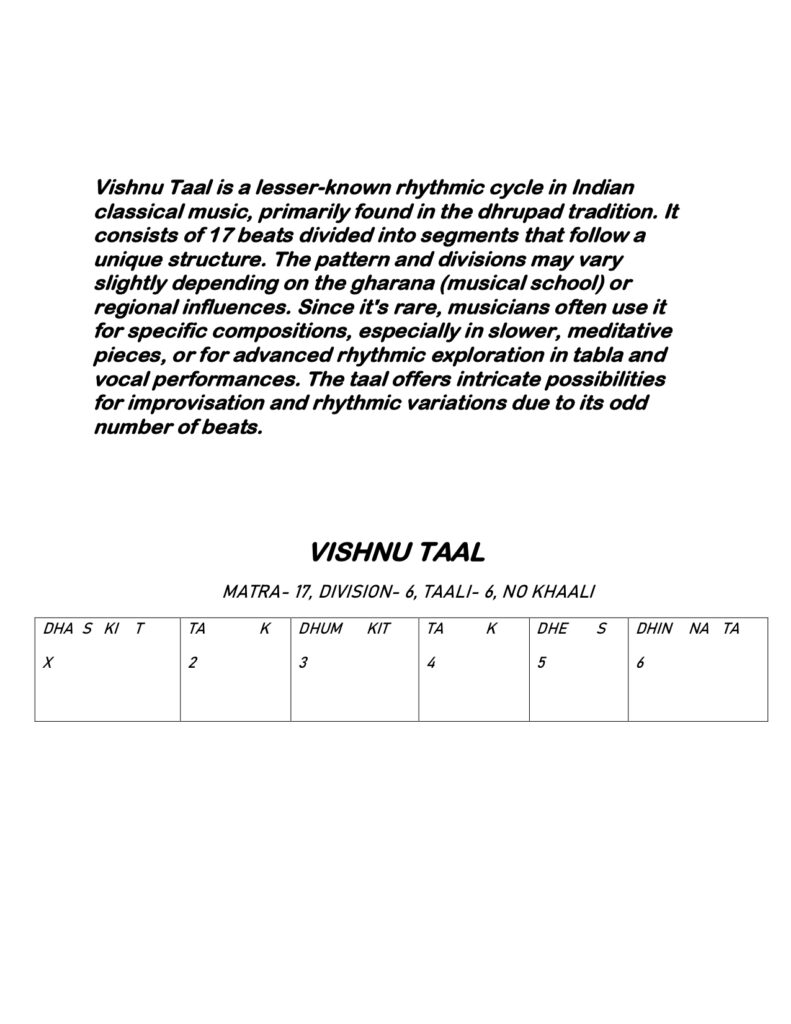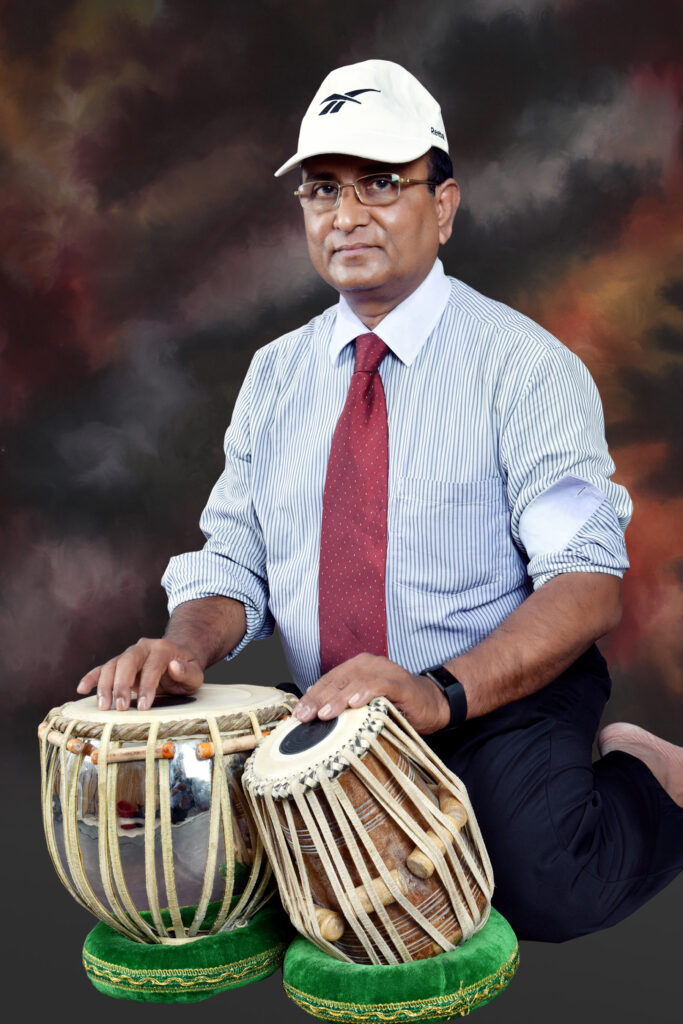Vishnu Taal (17 Beats) – A Rare and Divine Rhythm You Must Learn! Tabla, the soul of Indian rhythm, is filled with countless taals (rhythmic cycles) that define the structure of classical, devotional, and contemporary music. While popular taals like Teentaal (16 beats) and Jhaptal (10 beats) dominate performances, there are rare and complex rhythmic cycles that remain relatively unknown. One such hidden gem is Vishnu Taal, a 17-beat rhythm that holds deep musical and spiritual significance. Named after Lord Vishnu, the preserver in Hindu mythology, this taal carries a sense of divinity and balance. In this blog, we will explore Vishnu Taal’s structure, notation, and its place in Indian classical music.
What is Vishnu Taal?
Vishnu Taal is a 17-beat rhythmic cycle, making it one of the rarer taals in Indian classical music. Unlike common time cycles, this taal has an uneven yet balanced flow, which creates a unique rhythmic experience for tabla players and musicians.
As its name suggests, Vishnu Taal is often associated with devotional music, classical compositions, and traditional temple rituals, making it a taal of great spiritual depth.
Structure of Vishnu Taal
Vishnu Taal is divided into four vibhags (sections), arranged as:
📌 5 + 4 + 4 + 4
This division gives Vishnu Taal a distinctive rhythmic pattern that requires precision and skill to master.
Theka (Basic Tabla Pattern) of Vishnu Taal
👉 Dha Dhin Dhin Dha Dha | Dha Tin Tin Ta | Tin Tin Tin Tin | Dha Dhin Dhin Dha
Each section carries a unique weight, making it important for tabla players to maintain balance and flow while playing this taal.
Notation of Vishnu Taal
Here’s a detailed breakdown of Vishnu Taal’s structure:
| Matra | Bol (Stroke) |
|---|---|
| 1 | Dha |
| 2 | Dhin |
| 3 | Dhin |
| 4 | Dha |
| 5 | Dha |
| 6 | Dha |
| 7 | Tin |
| 8 | Tin |
| 9 | Ta |
| 10 | Tin |
| 11 | Tin |
| 12 | Tin |
| 13 | Tin |
| 14 | Dha |
| 15 | Dhin |
| 16 | Dhin |
| 17 | Dha |
This matra-wise breakdown helps tabla players visualize and internalize the rhythmic structure of Vishnu Taal.
Significance of Vishnu Taal in Music
Vishnu Taal, though rare, holds great value in Indian classical and devotional music. It is primarily used in:
🎵 Devotional Music & Bhajans – Since it is named after Lord Vishnu, it is often played in temple rituals and religious compositions.
🎵 Classical Instrumental Music – Some advanced tabla players use it for solo performances.
🎵 Fusion & Experimental Music – Modern artists have begun exploring its unique rhythmic flow in fusion compositions.
Its odd-numbered cycle (17 beats) makes it more unpredictable and complex compared to symmetrical taals, giving it a dynamic quality.
How to Practice Vishnu Taal?
Mastering Vishnu Taal requires dedicated practice and a strong sense of rhythm. Here are some practice tips:
✅ Start Slow – Recite the bol pattern before playing.
✅ Use a Metronome or Lehra – This helps in maintaining a steady rhythm.
✅ Break It Down – Practice each vibhag separately before playing the full cycle.
✅ Experiment with Variations – Try different kaidas and tukras within the 17-beat framework.
With patience and practice, you can master this divine and powerful rhythm!
Conclusion
Vishnu Taal is a rare and sacred 17-beat rhythm that offers a unique challenge to tabla players. Its balanced yet complex structure makes it a fascinating taal to learn and perform. Whether you’re a beginner or an advanced musician, adding Vishnu Taal to your repertoire will enhance your rhythmic skills and deepen your understanding of Indian classical music.

Vishnu Taal is a lesser-known rhythmic cycle in Indian classical music, primarily found in the dhrupad tradition. It consists of 17 beats divided into segments that follow a unique structure. The pattern and divisions may vary slightly depending on the gharana (musical school) or regional influences. Since it’s rare, musicians often use it for specific compositions, especially in slower, meditative pieces, or for advanced rhythmic exploration in tabla and vocal performances. The taal offers intricate possibilities for improvisation and rhythmic variations due to its odd number of beats.
Vishnu Taal is one of the rarer and less commonly known rhythmic cycles (taals) used in Indian classical music, particularly in the dhrupad style of the Hindustani classical tradition. It has a total of 17 beats. Unlike more common taals like Teen Taal (16 beats) or Ektaal (12 beats), Vishnu Taal’s odd number of beats gives it a distinctive character that is both challenging and interesting for musicians and listeners.
Key Features of Vishnu Taal:
- Beat Structure:
Vishnu Taal consists of 17 beats, divided into sections, known as vibhags (divisions). These vibhags can vary depending on the performer or the tradition, but they generally follow a pattern that balances the odd number of beats into smaller groups. - Typical Arrangement:
The arrangement of beats is often something like 4 + 4 + 4 + 5. This combination of smaller divisions within the 17-beat cycle allows for both rhythmic variation and intricate patterns in compositions. - Usage in Dhrupad:
Vishnu Taal is primarily used in the dhrupad genre, which is an ancient form of Indian classical music. Dhrupad is known for its meditative, slow, and profound approach to ragas, and taals like Vishnu Taal are employed in this context to add rhythmic complexity and depth to the performance. - Improvisational Opportunities:
The odd beat cycle of Vishnu Taal opens up a wide range of possibilities for layakari (rhythmic improvisation) on instruments like the tabla or pakhawaj. This makes it particularly challenging and rewarding for advanced musicians who are comfortable navigating unconventional time signatures. - Challenges in Performance:
Since it is a 17-beat cycle, Vishnu Taal is more difficult to master than some of the more standard taals with even numbers of beats. It requires a strong sense of rhythm and understanding of its divisions for both tabla players and vocalists. - Tihai and Tukra in Vishnu Taal:
In this taal, special rhythmic compositions such as tihais (a rhythmic pattern repeated three times) and tukras (short, sharp compositions) take on a unique form, as they must fit into the 17-beat structure.
Example of Beat Division:
An example of how Vishnu Taal could be divided is:
- Dha Dhin Dhin Dha | Dha Dhin Dhin Dha | Dha Tin Tin Ta | Dha Tin Tin Ta Ta
- This can be read as:
4 beats | 4 beats | 4 beats | 5 beats
Comparison to Other Taals:
- Teen Taal: 16 beats (4+4+4+4)
- Ektaal: 12 beats (2+2+2+2+2+2)
- Jhaptaal: 10 beats (2+3+2+3)
- Vishnu Taal: 17 beats (typically 4+4+4+5)
Not Common in Modern Performances:
Due to its complexity and limited usage, Vishnu Taal is not as frequently performed in contemporary Indian classical concerts as other popular taals. However, it remains a significant part of the rhythmic repertoire, especially in more traditional or experimental performances.
Where You Might Hear Vishnu Taal:
- Dhrupad recitals
- Advanced tabla solo performances
- Experimental fusion music
In summary, Vishnu Taal is an intriguing rhythmic cycle that offers both performers and listeners an opportunity to explore complex and dynamic rhythmic structures in Indian classical music. Its odd number of beats and use in dhrupad gives it a special place in the vast landscape of taals.


